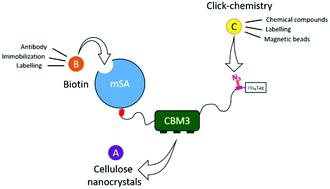当前位置:
X-MOL 学术
›
Biomater. Sci.
›
论文详情
Our official English website, www.x-mol.net, welcomes your feedback! (Note: you will need to create a separate account there.)
A tripartite carbohydrate-binding module to functionalize cellulose nanocrystals
Biomaterials Science ( IF 6.6 ) Pub Date : 2021-10-01 , DOI: 10.1039/d1bm01156a Angeline Pelus 1 , Gaëlle Bordes 2 , Sophie Barbe 1 , Younes Bouchiba 1 , Callum Burnard 1 , Juan Cortés 3 , Brice Enjalbert 1 , Jeremy Esque 1 , Alejandro Estaña 3 , Régis Fauré 1 , Anthony K Henras 2 , Stéphanie Heux 1 , Claude Le Men 1 , Pierre Millard 1 , Sébastien Nouaille 1 , Julien Pérochon 1 , Marion Toanen 1 , Gilles Truan 1 , Amandine Verdier 1 , Camille Wagner 1 , Yves Romeo 2 , Cédric Y Montanier 1
Biomaterials Science ( IF 6.6 ) Pub Date : 2021-10-01 , DOI: 10.1039/d1bm01156a Angeline Pelus 1 , Gaëlle Bordes 2 , Sophie Barbe 1 , Younes Bouchiba 1 , Callum Burnard 1 , Juan Cortés 3 , Brice Enjalbert 1 , Jeremy Esque 1 , Alejandro Estaña 3 , Régis Fauré 1 , Anthony K Henras 2 , Stéphanie Heux 1 , Claude Le Men 1 , Pierre Millard 1 , Sébastien Nouaille 1 , Julien Pérochon 1 , Marion Toanen 1 , Gilles Truan 1 , Amandine Verdier 1 , Camille Wagner 1 , Yves Romeo 2 , Cédric Y Montanier 1
Affiliation

|
The development of protein and microorganism engineering have led to rising expectations of biotechnology in the design of emerging biomaterials, putatively of high interest to reduce our dependence on fossil carbon resources. In this way, cellulose, a renewable carbon based polysaccharide and derived products, displays unique properties used in many industrial applications. Although the functionalization of cellulose is common, it is however limited in terms of number and type of functions. In this work, a Carbohydrate-Binding Module (CBM) was used as a central core to provide a versatile strategy to bring a large diversity of functions to cellulose surfaces. CBM3a from Clostridium thermocellum, which has a high affinity for crystalline cellulose, was flanked through linkers with a streptavidin domain and an azide group introduced through a non-canonical amino acid. Each of these two extra domains was effectively produced and functionalized with a variety of biological and chemical molecules. Structural properties of the resulting tripartite chimeric protein were investigated using molecular modelling approaches, and its potential for the multi-functionalization of cellulose was confirmed experimentally. As a proof of concept, we show that cellulose can be labelled with a fluorescent version of the tripartite protein grafted to magnetic beads and captured using a magnet.
中文翻译:

用于纤维素纳米晶体功能化的三方碳水化合物结合模块
蛋白质和微生物工程的发展导致人们对新兴生物材料设计中生物技术的期望越来越高,据推测,这对减少我们对化石碳资源的依赖具有很高的兴趣。通过这种方式,纤维素,一种可再生的碳基多糖及其衍生产品,在许多工业应用中显示出独特的特性。尽管纤维素的官能化很常见,但它在功能的数量和类型方面受到限制。在这项工作中,碳水化合物结合模块 (CBM) 被用作中心核心,以提供一种通用策略,为纤维素表面带来多种功能。来自热纤梭菌的CBM3a对结晶纤维素具有高亲和力,其侧翼是带有链霉亲和素结构域的接头,以及通过非规范氨基酸引入的叠氮基团。这两个额外的结构域中的每一个都用各种生物和化学分子有效地产生和功能化。使用分子建模方法研究了所得三方嵌合蛋白的结构特性,并通过实验证实了其在纤维素多功能化方面的潜力。作为概念的证明,我们表明纤维素可以用嫁接到磁珠并使用磁铁捕获的三方蛋白的荧光版本进行标记。
更新日期:2021-10-14
中文翻译:

用于纤维素纳米晶体功能化的三方碳水化合物结合模块
蛋白质和微生物工程的发展导致人们对新兴生物材料设计中生物技术的期望越来越高,据推测,这对减少我们对化石碳资源的依赖具有很高的兴趣。通过这种方式,纤维素,一种可再生的碳基多糖及其衍生产品,在许多工业应用中显示出独特的特性。尽管纤维素的官能化很常见,但它在功能的数量和类型方面受到限制。在这项工作中,碳水化合物结合模块 (CBM) 被用作中心核心,以提供一种通用策略,为纤维素表面带来多种功能。来自热纤梭菌的CBM3a对结晶纤维素具有高亲和力,其侧翼是带有链霉亲和素结构域的接头,以及通过非规范氨基酸引入的叠氮基团。这两个额外的结构域中的每一个都用各种生物和化学分子有效地产生和功能化。使用分子建模方法研究了所得三方嵌合蛋白的结构特性,并通过实验证实了其在纤维素多功能化方面的潜力。作为概念的证明,我们表明纤维素可以用嫁接到磁珠并使用磁铁捕获的三方蛋白的荧光版本进行标记。



























 京公网安备 11010802027423号
京公网安备 11010802027423号